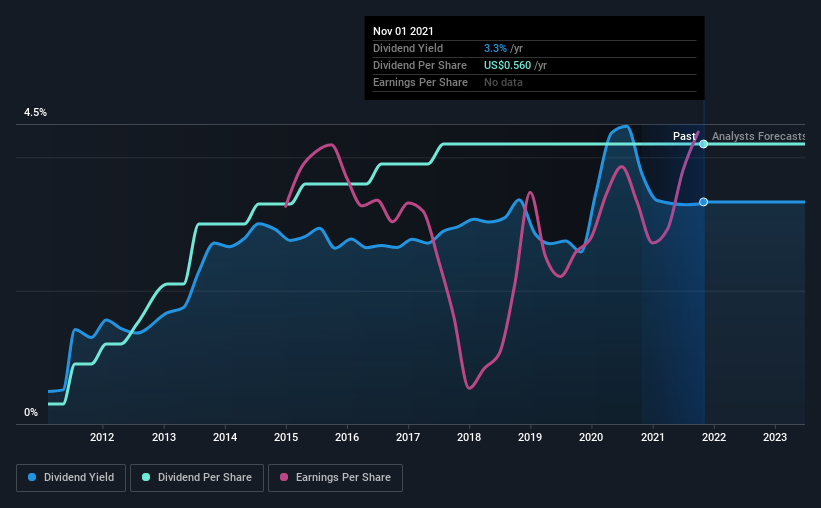- United States
- /
- Banks
- /
- NasdaqGS:PROV
Provident Financial Holdings (NASDAQ:PROV) Is Due To Pay A Dividend Of US$0.14

Provident Financial Holdings, Inc. (NASDAQ:PROV) will pay a dividend of US$0.14 on the 9th of December. Based on this payment, the dividend yield will be 3.3%, which is fairly typical for the industry.
See our latest analysis for Provident Financial Holdings
Provident Financial Holdings' Payment Has Solid Earnings Coverage
We like to see a healthy dividend yield, but that is only helpful to us if the payment can continue. Based on the last payment, Provident Financial Holdings was quite comfortably earning enough to cover the dividend. This means that a large portion of its earnings are being retained to grow the business.
Over the next year, EPS is forecast to fall by 23.6%. Assuming the dividend continues along recent trends, we believe the payout ratio could be 65%, which we are pretty comfortable with and we think is feasible on an earnings basis.

Provident Financial Holdings Has A Solid Track Record
Even over a long history of paying dividends, the company's distributions have been remarkably stable. Since 2011, the first annual payment was US$0.04, compared to the most recent full-year payment of US$0.56. This means that it has been growing its distributions at 30% per annum over that time. It is good to see that there has been strong dividend growth, and that there haven't been any cuts for a long time.
Provident Financial Holdings Could Grow Its Dividend
Investors who have held shares in the company for the past few years will be happy with the dividend income they have received. Provident Financial Holdings has seen EPS rising for the last five years, at 7.6% per annum. Earnings are on the uptrend, and it is only paying a small portion of those earnings to shareholders.
Provident Financial Holdings Looks Like A Great Dividend Stock
Overall, we like to see the dividend staying consistent, and we think Provident Financial Holdings might even raise payments in the future. The company is generating plenty of cash, and the earnings also quite easily cover the distributions. We should point out that the earnings are expected to fall over the next 12 months, which won't be a problem if this doesn't become a trend, but could cause some turbulence in the next year. Taking this all into consideration, this looks like it could be a good dividend opportunity.
It's important to note that companies having a consistent dividend policy will generate greater investor confidence than those having an erratic one. Still, investors need to consider a host of other factors, apart from dividend payments, when analysing a company. For instance, we've picked out 1 warning sign for Provident Financial Holdings that investors should take into consideration. Looking for more high-yielding dividend ideas? Try our curated list of strong dividend payers.
New: Manage All Your Stock Portfolios in One Place
We've created the ultimate portfolio companion for stock investors, and it's free.
• Connect an unlimited number of Portfolios and see your total in one currency
• Be alerted to new Warning Signs or Risks via email or mobile
• Track the Fair Value of your stocks
This article by Simply Wall St is general in nature. We provide commentary based on historical data and analyst forecasts only using an unbiased methodology and our articles are not intended to be financial advice. It does not constitute a recommendation to buy or sell any stock, and does not take account of your objectives, or your financial situation. We aim to bring you long-term focused analysis driven by fundamental data. Note that our analysis may not factor in the latest price-sensitive company announcements or qualitative material. Simply Wall St has no position in any stocks mentioned.
Have feedback on this article? Concerned about the content? Get in touch with us directly. Alternatively, email editorial-team (at) simplywallst.com.
About NasdaqGS:PROV
Provident Financial Holdings
Operates as the holding company for Provident Savings Bank, F.S.B.
Flawless balance sheet average dividend payer.
Similar Companies
Market Insights
Community Narratives




